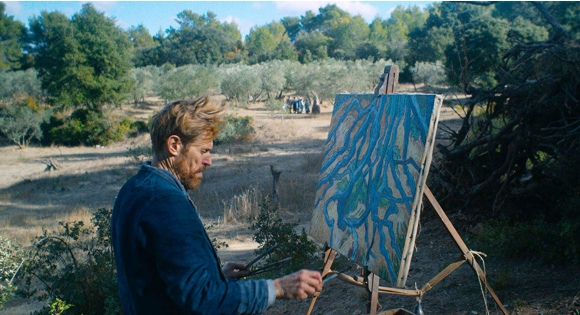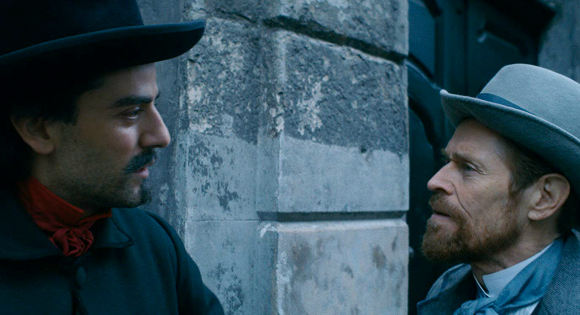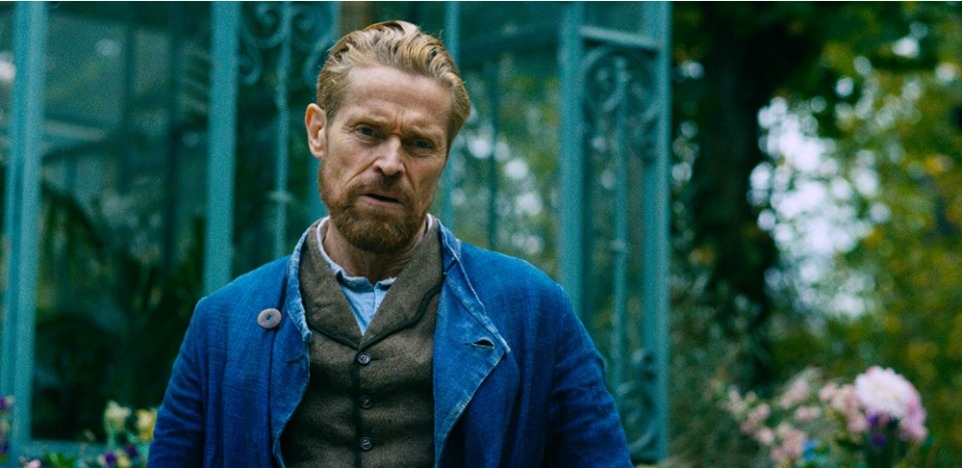At Eternity's Gate is surely the most empathetic film ever made about Vincent van Gogh, the tortured genius and deeply spiritual artist who opened our bodies, minds and souls to the wonders of a sense-luscious world. Master director Julian Schnabel (The Diving Bell and the Butterfly) has created a remarkable film out of the passionate acting of Willem Dafoe as Van Gogh, a treasure trove of emotions evoked by the music of Tatiana Lisovkaia, the revelatory cinematography of Benoît Delhomme, and the guiding light of the screenplay written by Schnabel, Jean-Claude Carriere, and Louise Kugelberg.

Schnabel set out to make a distinctly different biographical film. In the Director's Note, he writes, "His was a life lived rich with magic, profound communication with nature and the wonder of being. His unique perspective is one whose belief and vision make visible and physical the inexpressible. . . . This is about what it is to be an artist." He wants the viewer to see the world as Van Gogh the painter did, to experience the feelings associated with the act of creating art, and the devotional nature of the endeavor. "The Van Gogh seen in the film," he adds, "comes directly out of my personal response to his paintings, not just what people have written about him.”
Some of this is achieved by the cinematography and the life events covered in the film. But, thankfully, Schnabel also turns to Van Gogh's world-famous letters, which reveal over and over again how the artist uses nearly everything that happens as a connection to love, beauty, meaning, and the invisible. Willem Dafoe reads Vincent's letters to his brother Theo (Rupert Friend) and friends, including artist Paul Gauguin (Oscar Isaac).

The letters help us unlock the inner reserves of faith and hope that the artist calls upon as he copes with innumerable catastrophes and disappointments which plague him as he desperately tries to "paint what I feel and feel what I paint."
Here are some quotes from Van Gogh's letters which are both particular to his worldview and relevant to our own times. Hopefully, they will make it easier for you to make the most of your empathy with this artist.
Admire As Much As You Can
"Admire as much as you can; most people do not admire enough. . . . Always take many walks and keep your love of nature, for that is the true way to learn to understand art more and more. Painters understand and love her and teach us to see her." — Vincent Van Gogh
Vincent Van Gogh was entranced by the world of nature throughout his life. In scene after scene, he is seen running through fields and among trees. He says, "When I look at nature, I see the tie that connects us all." The director conveys the exuberance and joy of a man whose spirits are lifted by the beauty and bounty of the natural world — from a view of a distant landscape to the intimacy of a flower bed.
Love Many Things
"There are many things one must believe and love. The best way of knowing God is to love many things." — Vincent Van Gogh
Van Gogh's spiritual perspective enables him to always be on the lookout for things to reverence. A pair of old shoes became the subject of one of his most famous paintings. In the film, he admits, "I feel lost if I don't have something to look at."
Realize Great Things For Humanity
"To act in this world one must die to oneself. . . . Man is not down here on earth merely to be happy; he is not even placed here to be simply honest. He is here to realize great things for humanity." — Vincent Van Gogh
Whereas many other artists got caught up in the fame and money game, Van Gogh took the spiritual path. He sought to share his vision of what it means to be alive. "Painting," he wrote in a letter, "is a faith and it imposes the duty to disregard public opinion." In the film, he muses, "Maybe God made me a painter for people who aren't born yet. Life is for sowing. The harvest is not here yet."
Several scenes in the film show Van Gogh dealing with public indifference. Early on, a café owner asks him to take down his one-man show. We realize that he sold few paintings in his lifetime. After his death, people wander through the room where his casket lays, casually inspecting the paintings displayed there.
Long Looking
"It is looking at things for a long time that ripens and gives you deeper understanding." — Vincent Van Gogh
The art of long looking is a habit that must be nurtured by those who yearn to embrace the wide and always changing world of art. In one pivotal scene in the film, Van Gogh's friend, the artist Paul Gauguin, criticizes him for moving too quickly in his painting style. This was just one way Van Gogh was different from his contemporaries.
The Vibrations of Our Coloring
"I want to paint something eternal which we seek to give by the vibrations of our coloring." — Vincent Van Gogh
Van Gogh used colors like a writer uses words. In the final ten years of his life, he created over 1,700 works of art. And through this period of creative expression, he developed a genius for color. Van Gogh, the supreme loner, opened the doors for later artists to explore. As you watch the film, notice how the cinematography catches and amplifies Van Gogh's color palette.
Madness
"A grain of madness is the best of art." — Vincent Van Gogh
Director Schnabel describes his film's sources, besides the letters, as "common agreement about events in his life that parade as facts, hearsay, and scenes that are just plain invented." Included are moments when Van Gogh and those around him question his sanity and ability to function in the world. It becomes understandable that he could say, "I paint to stop thinking."
Which, in the end, is perhaps the best approach to this film — not to think about it but to sense it, to feel your connection with Van Gogh as you feel the wind moving through the grasses, are awed by the vibrant gold of a field, and moved by the mystery in the night sky.
